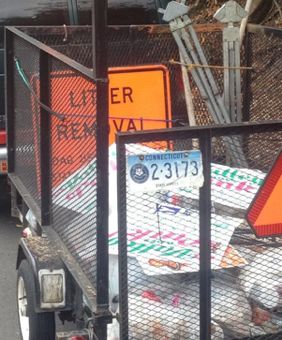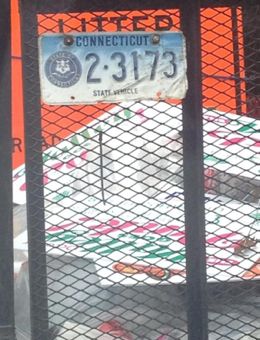
A “litter removal” crew from the state Department of Transportation removed “Valley Goes Pink” signs along Bridgeport Avenue in Shelton Thursday because they were obstructing motorists’ sight lines, a spokesman for the agency said.
State law prohibits signs of any sort from being put in the state’s right of way because of safety concerns.
But some Valley residents questioned the DOT’s strict adherence to the policy, given the nature of the signs and the number of other DOT-related issues in the area.
The Signs
The yard signs have been placed all over the lower Naugatuck Valley as part of the “Valley Goes Pink,” a series of community events in October to raise money for the Hewitt Center for Breast Wellness at Griffin Hospital, and to raise awareness about breast cancer prevention in general.
Some readers didn’t buy the DOT’s answer. One reader pointed out there were simply too many “Valley Goes Pink” signs along the road, having been placed every few hundred feet. Another reader asked whether the DOT removed other signs on Bridgeport Avenue, such as a sign promoting noted ghostbuster Lorraine Warren.
October is breast cancer awareness month, and it is an especially important issue in the lower Valley.
The roots of the “Valley Goes Pink” and Griffin’s breast wellness center were planted in 2005, when there was a sharp increase locally in the number of deaths from breast cancer.
“Seymour Pink“ is a similar grass roots effort with a ton of events scheduled for this month.
A 2011 report showed Connecticut had the second-highest breast cancer rate in the U.S.
 The same report, from Komen Connecticut, said Shelton was one of 39 towns in the state with a high breast cancer mortality rate.
The same report, from Komen Connecticut, said Shelton was one of 39 towns in the state with a high breast cancer mortality rate.
The Photos
Jeff Caporaso, a Shelton resident, sent the Valley Indy photos of the signs after they were removed by the DOT Thursday.
Caporaso was traveling along Bridgeport Avenue about noon when he noticed the workers near the signs.
After a trip to a nearby bank, he traveled back on Bridgeport Avenue, and, near South Constitution Boulevard, noticed the “Valley Goes Pink” signs were gone.
“I thought, ‘No. They didn’t take the signs, did they?’ Caporaso said.
He backtracked on Bridgeport Avenue and saw the signs in the back of a DOT trailer, atop bags of garbage.
He Tweeted the Valley Indy. We asked him to take photos.
For Caporaso, it wasn’t about playing “gotcha,” or attempting to embarrass the state agency.
Caporaso’s father died from breast cancer on Oct. 10, 2013.
“It’s not like these are tag sale signs or Realtor signs. They’re for breast cancer awareness and research,” Caporaso said.
Safety Issue
Kevin Nursick, a spokesman for the DOT, said a crew from his agency in Shelton only took down roadside signs that interfered with sight lines — that is, the area that allows a motorist to see what’s coming.
It was unclear how many signs were removed. He noted they have not been thrown away.
Nursick said the DOT removes the signs “as our priorities and resources allow.”
 The agency can’t pick and choose the types of signs to remove. Every sign is treated the same, he said. Nursick pointed out that thousands of political signs are removed every year for the same reason.
The agency can’t pick and choose the types of signs to remove. Every sign is treated the same, he said. Nursick pointed out that thousands of political signs are removed every year for the same reason.
It’s a safety issue, Nursick said.
“It’s not our waking intent every morning to go out and start removing illegal signs,” he said. “We remove them immediately if there is a safety concern or if there are complaints. No questions asked.”
The DOT also isn’t in a position to contact the sign owners and arrange for them to be removed.
Reaction
Caporaso, by the way, snapped the photos at the same time as the 14th Annual “Women Making A Difference In The Valley” luncheon was being held at the Grassy Hill Lodge in Derby.
A portion of the money from that event goes to the Valley Breast Health Care Fund.
State Sen. Joseph Crisco was honored at the event with a “special recognition award” by the Valley Women’s Health Initiative for his successful efforts to pass laws that bolster women’s breast health.
Crisco released a statement through a spokesman after learning the DOT had confiscated the signs:
 “There are rules for signs along state highways, and I understand those rules have to be observed, but I wish they had just left these signs alone,” Crisco said.
“There are rules for signs along state highways, and I understand those rules have to be observed, but I wish they had just left these signs alone,” Crisco said.
Len Greene, Jr., a former state legislator and a current member of the Seymour Board of Selectmen, said the DOT’s local priorities are out of whack.
“I’m not surprised they’re taking the signs down given the statute, but I do wish they would focus their attention on other pressing issues like patching the roads or cleaning up the side of Route 8 in Seymour,” Greene said.
He said Seymour Pink’s “Pounding the Pavement” 5k race is Saturday. Part of the race will pass by a DOT-owned fence.
“There is an unbelievable amount of trash on the state’s side of the fence along Cedar Street and Derby Avenue where the race route travels,” Greene said. “I think that would benefit the public much more than removing signs advertising for a good cause.”
Readers reacted on the Valley Indy Facebook page, too.
Anna Durante is a breast-cancer survivor from Derby. Every year her family hosts the Durante Family Brunch to raise money for the “Valley Goes Pink.”
Click here for info on this weekend’s brunch.
Durante said the DOT’s actions Thursday make her sad.
“I think its very sad when we can’t leave a few signs on the side of road to help raise money for a good cause, to help find a cure and to help the women who are going through cancer,” she said. “This money helps in all areas of treatment.”
Nursick said the “Valley Goes Pink” signs were not thrown in the trash. “Valley Goes Pink” reps should call 203 – 799-5072 to get them back. Ask for “Anthony.”
“The DOT doesn’t like being stuck in the precarious position of removing breast cancer awareness signage. That is a public relations nightmare for us,” Nursick said.
The Valley Indy reached out Thursday but did not hear back from Shelton Mayor Mark Lauretti, state Rep. Jason Perillo, and Griffin Hospital.
Valley Indy reporter Ethan Fry contributed to this report.